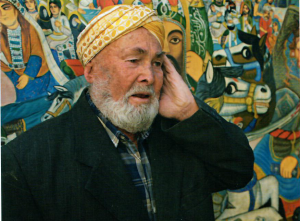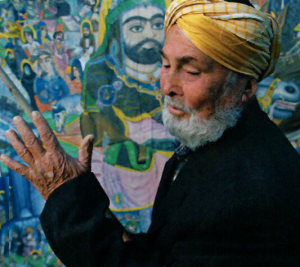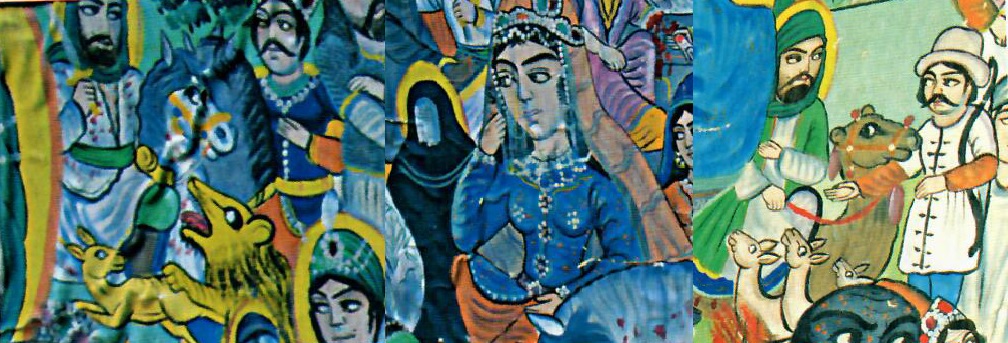Akbar abdollahzade
Akbar abdollahzade | |
|---|---|
 | |
| Born | 1933 Torbat Heydariye |
| Nationality | Iranian |
| Known for | Pardekhani and Ta'ziyekhani |
| Patron(s) | Karbalai Mohammad Salehi, Karbalai Mohammad Mashhad Ali and Karbalai Shokrollah Nurollahi |
Akbar Abdollahzade (born in 1933) is a prominent Iranian Pardekhan and Ta’ziyekhan from Torbat Heydariya, Iran. He started Pardekhani (curtain storytelling) when he was still 12 years old. His curtain was painted by Mohammad Ganji which illustrates the story of Sultan Qyes and Imam Hussain.
Performance Method
A concentrated posture facing the (curtain) gathering being described and stylized motions mainly with the hands and short movements of the body are the most important characteristics of this curtain-narrator. A penetrating look and passionate chanting causes this limited range of movements with a specific style next to the faces of the curtain to be adequate. Some of the postures of Morshed Akbar which are performed standing, such as placing the hands on top of the other, raising the hands in an indicative way in various directions, holding the cane in a specific position the posture of shooting arrows, clapping and other such movements are rarely found among the usual motions of the other curtain-storytellers .Therefore, one can say that he has innovated a set of new movements in addition to carrying out those known in Pardekhani.
Reciting Method
Morshed Akbar Abdollahzade uses the method of the Ta'ziya Ouliyakhans [1] in Pardekhani. In this method the Walikhan (Ouliyakhan singer) recites the text of the la Ziye (sung playing) and painted curtain in this case with a singing voice. The range of the pitches and their numbers are limited and corresponds to the atmosphere of Iranian [Dastgah http://www.iranicaonline.org/articles/dastgah] music. At the beginning of the Nasrani Girl's gathering, he uses the intervals of the first tetrachord of Bayat-e Turk. At the verses of Begoft ey ke toii morq e del e mara sayyad ... he enters into the second tetrachord. The singing at times moves onto the intervals of Abuata in the form of repeating type – melodies. In the second part of the picture-storytelling, in Sultan Qeys story, we hear the performance of the type -melodies which characterize Bayat-e Turk: Ey davaye dardmandan ya Hossein ... the sung poetry uses the rhythm of Masnavikhani and the atmosphere of Bayat-e Turk. In the third section of Zamen-e Ahu (Deer Keeper), the Pardekhan changes the previous atmosphere through emphasis on the first note, of the second tetrachord of Shur, the Shahed of Abuata, and the type-melodies of this gathering are distantly related to the second section in terms of the movement of the melodies and intervals of the notes and rests. In this section the range of melodies reaches the second tetrachord and most of the temporary pauses are on the Shahed of Abuata. Gradually, the next note after the Shahed of Abuata comes to play a greater role so that an atmosphere near that of the Nava Dastgah is created and the singing 'ends in this same atmosphere. [2]
Narration
The first gathering is that of the falling in love of the Nasrani (Christian) girl with Ali Akbar in a dream. The girl goes to Karbala in search of lover, the same place where Ali Akbar has been martyred. The second gathering is of Sultan of Qeys and Imam Hussain. In this gathering, Imam Hussain saves Sultan of Qeys from a lion. The third gathering relates to the story of Imam Rida and the Deer hunter. Imam Rida saves the captured deer from the hunter so it could return to give milk to its young.
Source
- Ardalan, hamidreza (2008). Picture-storyteller masters of iran, the Iranian academy of the art, 2008, volume 6. ISBN: 978-964-2986-408(vol.6). 978-964-2986-002(set).
References
- ↑ The Valikhan as opposed to the Ashghiakhan belongs among the holy personages and good characters. This group is allowed to sing their verses melodically with musical notes.
- ↑ The true tonality of Avaz e Abuata is Shure, so Avaz e Abuata tends towards notes of the first tetrachord of Shur, or Pishdong of Abuata. However, the Nava Dastgah while having intervals corresponding to those of Shur is an independent Dastgah and based on the Nature of the Dastgah, it is flowing at the beginning and tends towards the high tones . The second note of this Dastgah is particularly important and emphasis on this strengthens the structural atmosphere of the Nava Dastgah.


